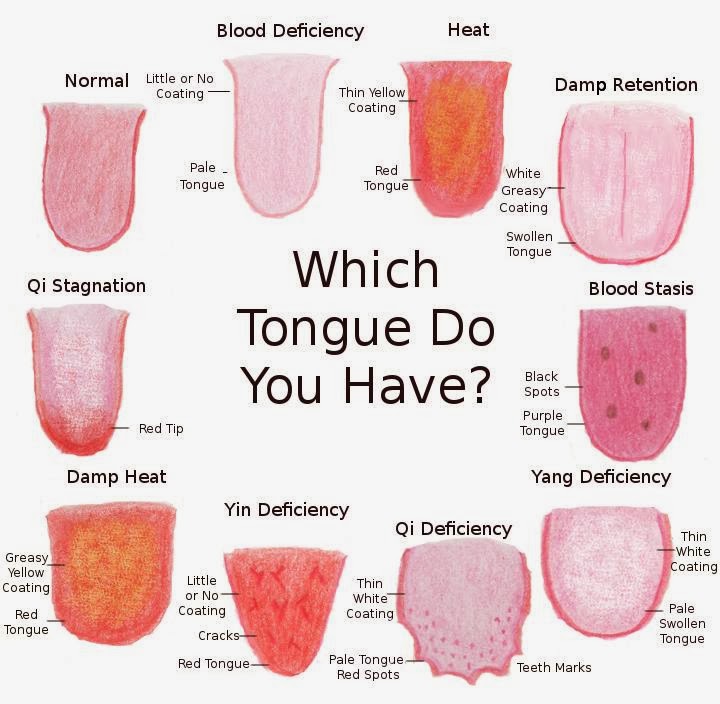The Color Of Your Tongue Can Reveal Health Problems

The color, texture and moisture of your tongue can be key in determining the overall state of your health. Here are some keys changes to look out for.
The tongue consists of a group of muscles that allow us to taste food, to swallow, and to talk. Naturopath Laurence Kirk of The British College of Naturopath and Osteopathy says “Your tongue is richly supplied with blood vessels, and thanks to a constant flow of saliva, it is constantly being cleaned which discourages harmful bacteria forming in the mouth area. However, if a person is unwell, a problem can often be detected by simply looking at the tongue.”
A single glance at your tongue can provide tell tale signs of what is going on within your body. When your tongue becomes discolored, swollen, stiff, sore or displays unusual features, take notice – your tongue is trying to tell you something.
Sometimes a change in its’ appearance can be an indication of a simple vitamin deficiency or merely a sign you need to pay a little more attention to dental hygiene. But in some instances it can be a sign of something more serious that needs medical attention.
Like many other health indicators, take a close look at your tongue in the mirror, then compare what you find with these tongue health warnings and know what is normal for you and your mouth. A healthy normal tongue should be pink in color with no imbalances or patches of differing texture or color. This shows a well balanced and functioning body.

Here are color common changes to be aware of:
1. BLACK TONGUE
The tiny bumps on a tongues surface are sometimes referred to as ‘hairs’, or papillae, and can sometimes turn black as a result of trapping bacteria and yeast. The color can also be attributed to the papillae becoming stained by some foods and tobaccos. Often poor oral hygiene is a major factor. This is a harmless but unsightly condition often referred to as ‘Black Hairy Tongue’.
However some antibiotics, mouthwashes and other medications can be responsible. It can be a sign of dehydration or drinking too much coffee. Heavy smokers may also suffer from this. It can result in a metallic taste in your mouth and bad breath. Use a tongue scraper or soft toothbrush to clean the tongue regularly and be sure to brush and floss your teeth properly. Consult a physician if this lasts more than 10 days.
2. YELLOW TONGUE
As with a black hairy tongue, this is a result of trapped bacteria. The papillae can become inflamed through being dehydrated, breathing through the mouth instead of nose, suffering from a fever or heavy smoking. As with black tongue ensuring meticulous oral hygiene should clear the problem, quickly returning the tongue to a healthy pink.
3. WHITE TONGUE
Some people develop a white colored coating or white spots appear on the tongue surface. This can have several causes:
Dehydration – easily rectified by drinking more water
Oral thrush – a yeast infection, or candida, can result in white sores appearing both on your tongue and mucus membrane lining of the mouth. People suffering from immune disorders and denture wearers are more at risk as are young infants and elderly people. Candida is also a common side effect in patients prescribed some harsh antibiotics.
Leukoplakia — Leukoplakia is a condition where there is an excessive growth of cells resulting in white patches inside the mouth as well as on the tongue. This most commonly occurs following any tongue irritation and is more common amongst smokers. It is usually harmless but can be a precursor to oral cancer – note changes and seek medical advice.
4. RED OR STRAWBERRY TONGUE
If your tongue is a bright shade of red and you have a fever seek medical attention immediately.
‘Strawberry tongue’ is so called as the red taste buds become swollen and appear to dot the surface of the normally smooth tongue just like the seeds of a strawberry. This can be as a result of the following:
Vitamin deficiency – Check your diet. Increase your levels of folic acid and vitamin B-12, by diet or supplement, as being deficient in these can cause your tongue to take on a reddish appearance.
Scarlet fever – This streptococcal infection often causes strawberry tongue. Contact your doctor immediately if you have a high fever and red tongue.
Kawasaki disease – Kawasaki disease(KD) is more common in children less than 5 years old, although it can also affect some older children or teenagers. It is a disorder characterized by the inflammation of blood vessels throughout the body. This can manifest itself as strawberry tongue alongside a high fever – seek medical advice.
5. BROWN TONGUE
A spot on the tongue that has turned brown or darkly discolored could possibly be a form of skin cancer called melanoma. Seek medical advice if you notice such changes.
6. LUMPS, BUMPS OR PAIN
Do you have a painful tongue in any area, or have small sore bumps appeared? Here are the main reasons these can occur:
Diabetes and anemia can cause a sore tongue
Smoking can irritate a sensitive tongue and cause soreness
Scalding is common if you eat food that is too hot, or bite your tongue whilst chewing
Some women report a burning feeling in their tongues post-menopause
Stress can result in canker sores
An irritated or infected taste bud can cause the papillae to swell and become painful
Oral cancer is more common amongst smokers and drinkers, consult a physician if a lump or sore spot lasts longer than 2 weeks.
Cracks or small cuts on the surface of the tongue can indicate a fungal infection such as oral thrush and can also mean increased sweating, irritability and trouble sleeping.
7. NUMBNESS OR TINGLING FEELING
The absence of feeling or sensations on your tongue most commonly occurs following damage to your nervous system. This could be following dental procedures including wisdom tooth extraction, root canal work or dental implants.
Stroke sufferers can also have damaged nerves leading to the tongue which results in numbness or tingling feelings.
Tips for a Healthy Tongue
* Eat organic yogurt with natural probiotics
* Quit smoking and using tobacco products
* Reduce alcohol intake
* Brush twice a day and floss on a regular basis
* Gargle with salt water
* Rinse your mouth after you eat
Any time that you notice pain, burning, swelling, changes in your ability to taste, abnormal movements, or difficulty moving the tongue, do not hesitate to see a doctor.
Please share this information with others by hitting one of the share buttons below.













 © 2024
© 2024
1 Comment